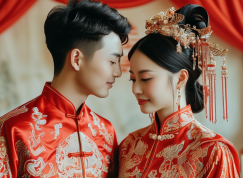中式婚嫁:三书六礼的浪漫契约

Chinese weddings are full of interesting customs and traditions. Let’s explore some fascinating facts about them.
The Three Letters and Six Etiquettes (礼仪)
After matchmaking, the proposal is confirmed with a formal letter of betrothal (订婚), which is the first of three letters. This letter outlines the couple’s intention to marry and their vows.
Next comes the gift letter, detailing the expected gifts. The final letter is the wedding letter, officially welcoming the bride into the groom’s family.
The “six etiquettes” include proposing, matching birthdates, exchanging betrothal gifts, giving wedding gifts, choosing the wedding date, and the ceremony itself.
A fortune-teller matches the couple’s birthdates to predict the success of their marriage.
The Wedding Tea Ceremony
Despite modern influences, the Chinese wedding tea ceremony remains a crucial part of the celebration. Tea is an important part of Chinese culture and traditionally included in a bride’s dowry (嫁妆).
Typically the ceremony is held at the couple’s respective homes on the wedding day, but some couples have the ceremony for both families before the wedding dinner. During the ceremony, the couple serves tea to elders in order of seniority, starting with the oldest and ending with the youngest. It is important for the couple to serve their paternal relatives before their maternal ones.
For more details on this unique custom, click here: Chinese Wedding Tea Ceremony.
Joining of Hair
In traditional Chinese culture, one’s hair represents one’s self. At a traditional Chinese wedding, the bride and groom cut a lock of their hair, tie it in a knot, and place it in a bag. This small ritual signifies their union and future happiness together.
原创编写 版权所有 侵权必究! 每日更新 个性化阅读 英语飙升!